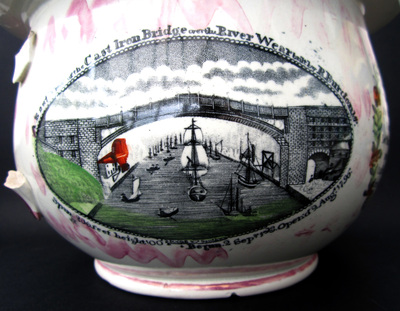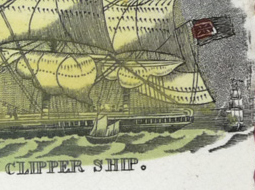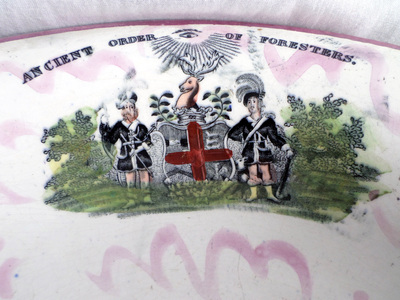|
7/13/2014 0 Comments Odds and endsGeneral Joseph GaribaldiThanks to Elinor Penna for providing the right image below of a brown-bordered plaque titled 'General Joseph Garibaldi'. Although the green used is different - there are at least three variants of green enamel that appear on these plaques - it is otherwise decorated very similarly to Norman Lowe's Scott-impressed bowl (left below). Although the bowl is marked Scott, you can see in this photo the typical zig-zag decoration, like a letter M, used by Moore. Garibaldi visited London in 1864 and it's possible that these items were made to cash in on this visit. This transfer, however, also appears on earlier Moore plaques, and might have originated at the time of Garibaldi's stay in Tyneside in 1854. Joseph is, of course, the anglicised form of Giuseppe. Moore and Scott flowersThanks to Norman Lowe for the photos of the chamber pot below (first three images) from the 1850s. It has a bridge transfer with the small inscription, 'Moore & Co Southwick', underneath (see top centre detail). It also has flower decoration (what better place to have posies of flowers than around the rim of a po?). As discussed already, flower decoration is more commonly associated with Scott's. Look at the jug below, with a similar bridge transfer, but with a hard-to-read Scott inscription. At first glance the flowers on the items look very similar. So could the two potteries have shared the same copper plates with flower transfers? I still believe the answer to be an emphatic, 'No'. Look at the details below: the left from the Moore chamber pot, the right from the Scott jug. Although one set of flowers is clearly copied from the other, they come from different transfer plates. Moore's appears to have stopped decorating items with flowers sometime in the 1850s, whereas, as discussed in previous posts, Scott's continued into the 1860s. It isn't beyond the realms of possibility that one day a jug or bowl will appear with the common ship transfers and flower decoration. However, I'd expect the flowers to be Moore's. Dixon transfers acquired by ScottThanks to Ian Holmes for the photo of the Scott-impressed bowl below, which has the whole gamut of Dixon transfers: The Gauntlet Clipper Ship, The Agamemnon in a Storm, Garibaldi, and the Dixon Crimea transfer. You can see all the transfers on Ian's United Collections website, along with several other impressed bowls, which all sit nicely with the narrative of my previous post. I've struggled to reconcile some of the transfers on this bowl with the Dixon versions (see the circular plaque below). However, the Dixon bowl (centre below) shows how degraded the transfer had become by the 1860s. The image of Garibaldi on the Scott bowl (right below) might have been so extensively re-engraved that it looks like a different transfer. The engraver, perhaps having no clear imprint to work from, simplified the folds in the collar and re-hatched the body of the coat. There's still room for doubt though, and the Scott version might simply be from a different copper plate. It's difficult to read some of the other transfers on the Scott bowl because the transfers are applied to a curved surface, and chunks are missing. The Gauntlet is titled 'CLPER SHP' instead of 'CLIPPER SHIP' (see right below). But I'm more confident that it is the same transfer that appears on Dixon plaques from the 1850s and 60s (left below) and Scott plaques from the 1860s and 70s (centre below). One transfer on Ian's Scott bowl is nothing like its Dixon counterpart (left below) - Ancient Order of Foresters. The transfers on the Scott-attributed plaque (centre below) and Ian's Scott bowl (right below) are clearly from the same transfer plate. But they are so different to the Dixon version that it's certainly more than a case of re-engraving. Perhaps the transfer was so worn that Scott's commissioned a new one. Perhaps the transfer wasn't on the same copper plate as The Gauntlet, and was simply one of Scott's own mixed and matched on the bowl. We may never know. Theories have to be tested, retested and retested again. Although the picture is far from being straightforward, I haven't yet found anything that's shaken my belief that the plaques, jugs and bowls from the 1860s with common ship transfers were decorated at Moore's. In fact, the more items I look at, the more sure I've become.
0 Comments
Leave a Reply. |
AuthorStephen Smith lives in London, and is always happy to hear from other collectors. If you have an interesting collection of plaques, and are based in the UK, he will photograph them for you. Free advice given regarding selling and dispersal of a collection, or to those wishing to start one. Just get in touch... Archives
February 2022
AcknowledgementsThis website is indebted to collectors, dealers and enthusiasts who have shared their knowledge or photos. In particular: Ian Holmes, Stephen Duckworth, Dick Henrywood, Norman Lowe, Keith Lovell, Donald H Ryan, Harold Crowder, Jack and Joyce Cockerill, Myrna Schkolne, Elinor Penna, Ian Sharp, Shauna Gregg at the Sunderland Museum, Keith Bell, Martyn Edgell, and Liz Denton.
|




























